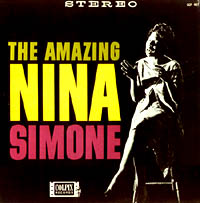The Amazing Nina Simone
Appearance
This article relies largely or entirely on a single source. (April 2017) |
| The Amazing Nina Simone | ||||
|---|---|---|---|---|
 | ||||
| Studio album by | ||||
| Released | 1959 | |||
| Recorded | 1959 | |||
| Studio | Van Gelder Studio, Hackensack, New Jersey | |||
| Genre | Vocal jazz, jazz, blues, gospel | |||
| Length | 33:31 | |||
| Label | Colpix | |||
| Producer | Hecky Krasnow | |||
| Nina Simone chronology | ||||
| ||||
The Amazing Nina Simone is a 1959 studio album by Nina Simone.[1] It was her first album for Colpix Records, which were followed by eight albums on the same label, before signing with Philips Records in 1964. The album features a variety of material including jazz, gospel, and folk songs. Compared to her debut, which showcased Simone's piano playing ability in addition to her singing, the piano was downplayed on this album in favor of string arrangements.[1]
Track listing
- "Blue Prelude" (Joe Bishop (m), Gordon Jenkins (l)) – 3:15
- "Children Go Where I Send You" (Simone, Traditional) – 2:45
- "Tomorrow (We Will Meet Once More)" (Jerry Silverman, Stephen Gale) – 2:56
- "Stompin' at the Savoy" (Benny Goodman (m), Chick Webb (m), Edgar Sampson (m), Andy Razaf (l)) – 2:05
- "It Might as Well Be Spring" (Richard Rodgers (m), Oscar Hammerstein (l)) – 3:50
- "You've Been Gone Too Long" (Brother John Sellers) – 2:08
- "That's Him Over There" (Lew Spence (m), Marilyn Keith (l)) – 2:28
- "Chilly Winds Don't Blow" (William Lovelock, Hecky Krasnow) – 2:40
- "Theme From Middle of the Night" (George Bassman (m), Paddy Chayefsky (l)) – 2:25
- "Can't Get Out of This Mood" (Jimmy McHugh (m), Frank Loesser (l)) – 2:30
- "Willow Weep for Me" (Ann Ronell) – 3:10
- "Solitaire" (King Guion (m), Carl Nutter (l), Renee Borek (l)) – 3:20
Personnel
- Nina Simone – vocals, piano
- Bob Mersey – arrangement, conductor
- Herb Snitzer – photography
References
- ^ a b Scott Yanow. "The Amazing Nina Simone – Nina Simone | Songs, Reviews, Credits". AllMusic. Retrieved 2017-04-01.
